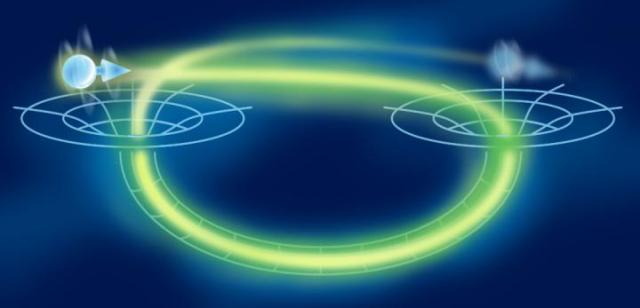Dec 10 2015
Why send a message back in time, but lock it so that no one can ever read the contents? Because it may be the key to solving currently intractable problems. That's the claim of an international collaboration who have just published a paper in npj Quantum Information.
 If the universe allows 'open timelike curves', particles travelling back in time along them could help to perform currently intractable computations. Even though such curves don't allow for interaction with anything in the past, researchers writing in npj Quantum Information show there is a gain in computational power as long as the time-travelling particle is entangled with one kept in the present. Credit: Adapted from npj Quantum Information, doi:10.1038/npjqi.2015.7 (2015)
If the universe allows 'open timelike curves', particles travelling back in time along them could help to perform currently intractable computations. Even though such curves don't allow for interaction with anything in the past, researchers writing in npj Quantum Information show there is a gain in computational power as long as the time-travelling particle is entangled with one kept in the present. Credit: Adapted from npj Quantum Information, doi:10.1038/npjqi.2015.7 (2015)
It turns out that an unopened message can be exceedingly useful. This is true if the experimenter entangles the message with some other system in the laboratory before sending it. Entanglement, a strange effect only possible in the realm of quantum physics, creates correlations between the time-travelling message and the laboratory system. These correlations can fuel a quantum computation.
Around ten years ago researcher Dave Bacon, now at Google, showed that a time-travelling quantum computer could quickly solve a group of problems, known as NP-complete, which mathematicians have lumped together as being hard.
The problem was, Bacon's quantum computer was travelling around 'closed timelike curves'. These are paths through the fabric of spacetime that loop back on themselves. General relativity allows such paths to exist through contortions in spacetime known as wormholes.
Physicists argue something must stop such opportunities arising because it would threaten 'causality' -- in the classic example, someone could travel back in time and kill their grandfather, negating their own existence.
And it's not only family ties that are threatened. Breaking the causal flow of time has consequences for quantum physics too. Over the past two decades, researchers have shown that foundational principles of quantum physics break in the presence of closed timelike curves: you can beat the uncertainty principle, an inherent fuzziness of quantum properties, and the no-cloning theorem, which says quantum states can't be copied.
However, the new work shows that a quantum computer can solve insoluble problems even if it is travelling along 'open timelike curves', which don't create causality problems. That's because they don't allow direct interaction with anything in the object's own past: the time travelling particles (or data they contain) never interact with themselves. Nevertheless, the strange quantum properties that permit 'impossible' computations are left intact. "We avoid 'classical' paradoxes, like the grandfathers paradox, but you still get all these weird results," says Mile Gu, who led the work.
Gu is at the Centre for Quantum Technologies (CQT) at the National University of Singapore and Tsinghua University in Beijing. His eight other coauthors come from these institutions, the University of Oxford, UK, Australian National University in Canberra, the University of Queensland in St Lucia, Australia, and QKD Corp in Toronto, Canada.
"Whenever we present the idea, people say no way can this have an effect" says Jayne Thompson, a co-author at CQT. But it does: quantum particles sent on a timeloop could gain super computational power, even though the particles never interact with anything in the past. "The reason there is an effect is because some information is stored in the entangling correlations: this is what we're harnessing," Thompson says.
There is a caveat -- not all physicists think that these open timeline curves are any more likely to be realisable in the physical universe than the closed ones. One argument against closed timelike curves is that no-one from the future has ever visited us. That argument, at least, doesn't apply to the open kind, because any messages from the future would be locked.